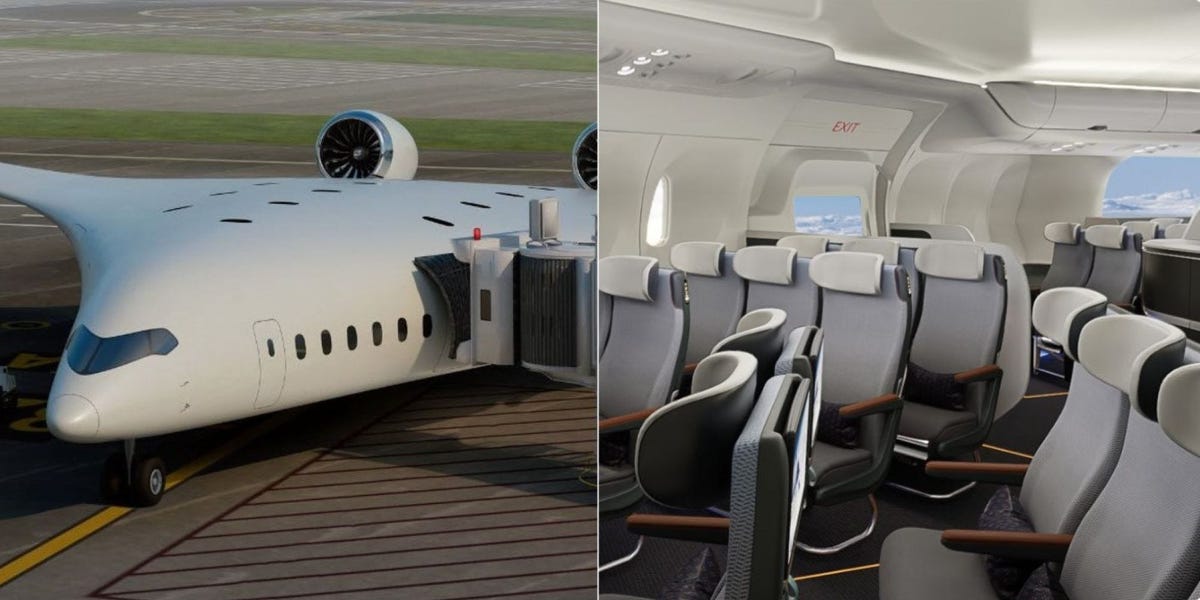See the New Spaceship-Like Plane That a Startup Wants to Certify by 2030

There are already concepts like zero-emission electric planes, supersonic jets and even hypersonic planes. But the latest example of these new aircraft types is the “Pathfinder,” a stealth bomber-like jet designed by California-based aerospace company JetZero.
The jet features a “blended wing body” or BWB, a design in which the wing and fuselage are combined into one.
After years of development, JetZero has built a 1:8 demonstrator, and the Federal Aviation Administration has just given the funky-shaped machine the green light to fly, CNN reported Thursday.
JetZero confirmed the news to Business Insider, saying “flights will begin in the coming months” to test “the stability and control characteristics of JetZero’s blended wing body design, as well as the operation of its system innovative landing gear.
The FAA told BI on Thursday that it “does not comment on current certification projects” and that “safety will dictate the timeline.”
JetZero builds single-deck ultra-wide-body airliner
JetZero is pitching its upcoming ultrawide jetliner as a “mid-market” airliner that can seat up to 250 people, meaning its rows could span 15 or 20 seats, JetZero told CNN. co-founder and CEO of JetZero, Tom O’Leary.
The jet would be a replacement option for traditional twin-engine widebodies like the Boeing 767, for example, according to JetZero.
JetZero must determine if and how Pathfinder will impact airport parking space. JetZero
“The airliner can integrate seamlessly into today’s infrastructure,” the company told BI. “Passenger capacity of a small widebody but weight and engine requirements of a single-aisle jet.”
Pathfinder also has military applications, with the US Air Force awarding $235 million to JetZero in August to develop a commercial-scale demonstrator, which JetZero told BI it plans to build by 2027.
The company said it expects the certified airliner to enter the market as soon as 2030, which aviation analyst Bailey Miles of consultancy AviationValues told CNN “inconceivable” given of the complexity of the BWB design.
Nonetheless, he said the concept “is extremely promising and could be a game-changer in the aviation industry.”
Blended-wing body significantly reduces fuel consumption but will face design challenges
JetZero said it chose this specific BWB design because of its carbon emissions reduction benefits.
According to the US Air Force, the all-in-one wing reduces drag by 30% and increases lift, effectively reducing fuel consumption and increasing global range.
The military version of the Pathfinder. JetZero
Additionally, JetZero said the engines would eventually be developed to run on hydrogen, which would be emissions-free. Meanwhile, early versions of Pathfinder would burn 50 percent less fuel by using borrowed engines, like those in the Boeing 737, CNN reported.
Michael Bragg, a professor of aerospace at the University of Illinois, told Business Insider that developing lighter but still strong composite materials is key to reducing the fuel consumption of BWB aircraft such as Pathfinder.
He also said engineers spread the load across the entire plane, which negates the “bending moment” between the tube and wings of a traditional plane. Composite technology makes this new load capacity possible, Bragg told BI.
Despite Pathfinder’s sound design on paper, Bragg said that proving and certifying a completely new aircraft concept is much more difficult than developing a traditionally shaped airliner.
“The product is essentially a new airframe and flight controls combined with existing systems already certified for commercial flights,” JetZero told BI.
Classic tube-and-wing aircraft design dates back to the 1950s dawn of the jet era on planes like the Boeing 707 and Douglas DC-8 and has continued today on large -modern carriers such as the Airbus A350 and the future Boeing 777X.
The Pathfinder interior concept. JetZero
Such proven technology has a proven track record, so there has been little incentive to change conventional aircraft designs over the decades because using proven technology minimizes safety risks and makes it easier to production, Bragg said.
“A lot of this is due to the manufacturing sector,” he said. “It is easy to make a tube and, although less simple, it is a well-known process for constructing the wings to attach.”
Beyond the assembly line, Bragg told BI that JetZero must ensure passengers are comfortable in the Pathfinder’s unique shape.
For example, he told BI that pressurization inside the plane – which helps humans breathe at high altitudes – is difficult to engineer into the body’s very large structure. And most of those 200-plus passengers would be in the windowless middle section, which Bragg said could put off travelers.
JetZero says on its website that its cabin is more efficient for boarding and deplaning and will have space for each person’s carry-on baggage.
Pathfinder has been in the works for 100 years
JetZero’s Pathfinder is poised to become a revolutionary technology if it ever hits the market, but it’s not a new idea.
According to CNN, engineers designed a similar wing shape about 100 years ago. Later, American industrialist and aeronautical designer Jack Northrop built his famous “Flying Wing” aircraft in the 1940s, laying the framework for the eventual B-2 bomber.
A B-2 bomber refueled in flight. USAF via Getty Images
Development resumed in 1988 when McDonnell Douglas responded to NASA’s challenge to build more revolutionary aircraft designs, which was followed by MD’s merger with Boeing in 1997 and the subsequent construction of the X-48B/C BWB jointly manufactured by NASA and Boeing.
businessinsider




